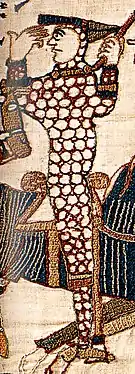
William I (circa 1028 – 9 September 1087), usually known as William the Conqueror, was the first Norman King of England, reigning from 1066 until his death in 1087. Descended from Viking raiders, he had been Duke of Normandy since 1035 under the title of William II. After a long struggle to establish his power, by 1060 his hold on Normandy was secure, and he launched the Norman conquest of England in 1066. The rest of his life was marked by struggles to consolidate his hold over England and his continental lands and by difficulties with his eldest son. In 1086 William ordered the compilation of the Domesday Book, a survey listing all the landholders in England along with their holdings. William died in September 1087 while leading a campaign in northern France, and was buried in Caen. His reign in England was marked by the construction of castles, the settling of a new Norman nobility on the land, and change in the composition of the English clergy. He did not try to integrate his various domains into one empire, but instead continued to administer each part separately. (Full article...)